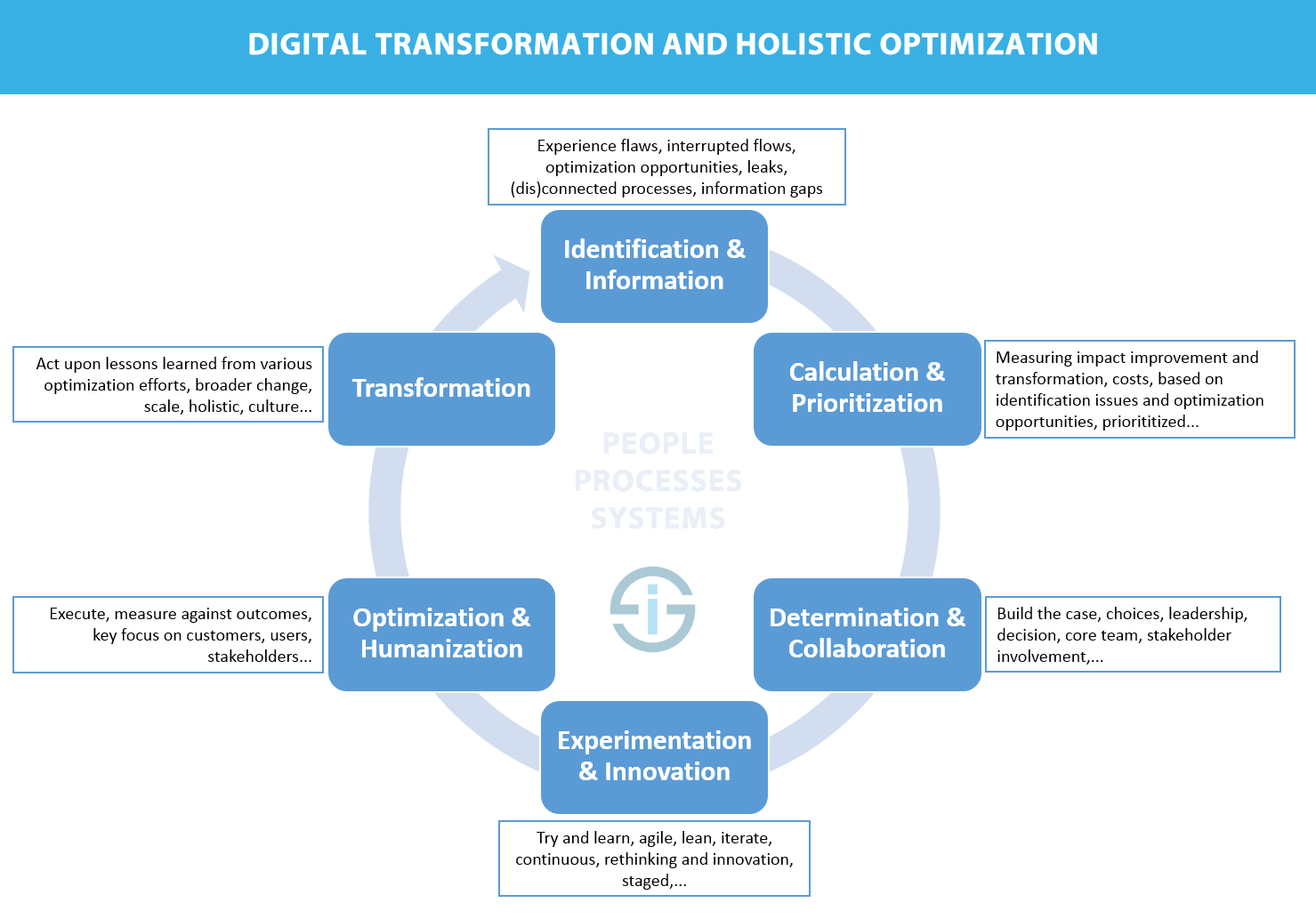 It’s been a few years now since we started talking about digital transformation as one of the core drivers in the evolution of organizations in a hyper-connected and increasingly real-time context.
It’s been a few years now since we started talking about digital transformation as one of the core drivers in the evolution of organizations in a hyper-connected and increasingly real-time context.
Thus far we tried to steer away as much as possible from technologies and limited views on so-called disruptive business models, even if they are all part of it. Customers, stakeholders and value first. Digital transformation now clearly has become the next big term and that isn’t without risks, especially if we forget the core objective of optimization and instead focus on the next shiny thing or technologies alone.
The purpose of transformation: innovation leads to optimization
Obviously we weren’t the only ones to analyze the essence of digital transformation and where it plays most today (namely the – predominantly digital – customer experience). Everyone who has worked were IT, business and information/content meet eachother and who ‘lived’ the de facto evolutions in the enterprise (and I do mean all of them) noticed ‘something’ was happening and, more importantly, needed to happen. We needed to dramatically improve how we conducted business. In that sense, digital transformation, always felt logical: it just had to ‘happen’, despite all the other factors that made it happen.
Because that’s what digital transformation essentially strenghtens more than ever: the fact that optimization (in a highly connected and ubiquitous sense) isn’t a choice anymore. Despite the clear role of ‘digital’ it’s essential to focus on the second word of the term: transformation. And that can mean many things. But it always happens with a purpose and involving many stakeholders in often new, agile and innovative ways. Innovation is optimization. Or better: ‘disruptive’ (to use the word) innovation only works if it optimizes. The customer experience, for instance. Why else is data so important? What else is the use of cognitive systems? Or why else would anyone care about the Internet of Things?
Why else do we use the technologies of the good old third platform which in turn have strengthened the need to optimize for the ways ‘consumers’ use them? SMAC (social, mobile, analytics and cloud) and all the technologies we added to the third platform or Gartner’s Nexus of Forces if you prefer only make sense in a context of optimization with business value and customer value(s) going hand in hand. With optimization of business processes and customer experience going hand in hand. And, yes, with cost savings and contextual relevance in the eyes of the customer going hand in hand. Truth be told: organizations still focus on cost savings and revenues first and customer experience is still a lot about lip service. Yet, in the end, if it doesn’t lead to meaning, relevance, context and optimization it doesn’t mean a thing and will decreasingly do so.
Seeing the links isn’t enough anymore: optimization takes action and transformation
That clear ‘connected optimization’ aspect was and is so interesting when it comes down to digital transformation for us, to begin with. Organizations have been conducting business from a siloed perspective since ever. For believers in a customer-centric and integrated approach and for optimization fanatics, such as ourselves, connecting dots across disciplines and mapping the links between any form of optimization or innovation is – and should be – an obsession. And it doesn’t matter which technology we are talking about or is joining the pack. Innovation and optimization capacity are cornerstones of digital transformation.
Digital transformation is where the (missing) links of a hyper-connected reality are seen, built and turned into business reality. Where they become relevance, context and optimization for the present AND the future.
True, it’s not easy to go beyond “seeing” the need for a holistic and stakeholder-centric (human) optimization approach. It’s often easier for
organizations to focus on siloed efforts and keep working in perfect containers. And that’s easy to understand. After all: once you really start seeing all the links between people, processes, information, data, experiences, emotions, work, market evolutions, business challenges, various divisions etc. that need to connect, often integrate, sometimes change and always strive towards holistic optimization the picture can quickly become scary. But hiding from reality never was the best option and reality is complex. Fortunately there are ways to deal with it and turn it all into benefits rather than challenges. Think prioritization, different ways of working together, rethinking systems with a focus on speed and integration in function of customer and outcome, etc.

It does come with choices to make. In this age of digital transformation there is, however, one thing that isn’t optional anymore: the choice to make choices or the choice to optimize.
Because, we can’t stress it enough, that is a core reason to transform: optimization as it always should have been and as, today, it is influenced by ever more evolutions. Digital for sure. With profit in mind without a doubt. And with optimization for human outcomes as the only way to achieve it.
Innovation and optimization capacity are cornerstones of digital transformation.
Top image purchased under license from Shutterstock

